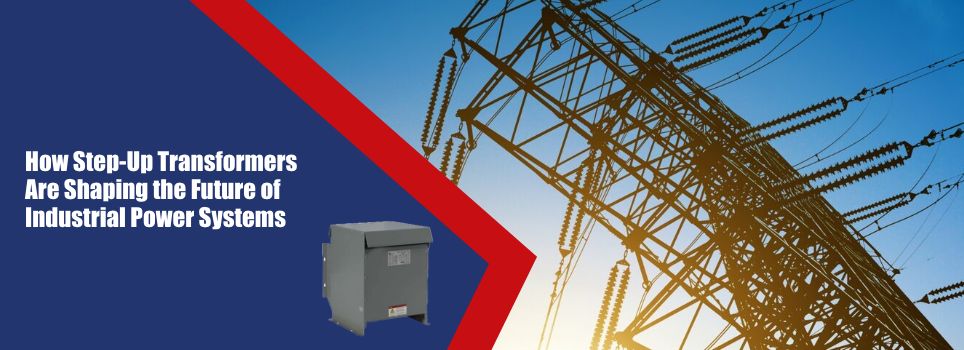
Global industries are rapidly changing, with energy demands continuing to expand and a demand for more efficient power systems rising accordingly. As industries transition toward advanced machinery and technology, electrical systems and their components become ever more vital; step-up transformers play a pivotal role in optimizing voltage distribution while providing for efficient electrical energy distribution across various applications.
In this blog, we’ll explore the different aspects of step-up transformers, focusing on their operation, components, and applications, particularly in industrial settings.
What is A Step-Up Transformer?
A step-up transformer is an electrical transformer designed to raise voltage from lower levels to higher ones, making them especially valuable in industrial settings that require long distance power transmission or for machinery that needs specific higher voltages to operate optimally.
Step-up voltage transformers work on an easy principle: electromagnetic induction changes the voltage between two coils or windings–one primary and one secondary. In doing this, power flows from lower voltage sources into primary coil for transmission at higher voltage through secondary coil. This arrangement makes step-up transformers ideal for high-voltage industrial machinery or long-distance transmission applications.
As an example, in the case of a 240 to 480 transformer, its output can be raised from 240V (supply or power source voltage) to 480V in order to meet the power requirements of the equipment.
How a Step-Up Transformer Works
The operation of a three-phase step-up transformer relies on Faraday’s law of electromagnetic induction. It consists of two coils–primary and secondary coils–wound around a magnetic core, where current passes from primary coil to secondary coil through AC current flow and creates a magnetic field, inducing current through secondary coil and producing either higher or lower voltage depending on coil turns ratio.
Components of a Step up Transformer Industrial step-up transformers contain several essential parts that ensure optimal operation:
- Core: Transformer cores are typically constructed of laminated sheets of silicon steel to focus the magnetic flux generated by current flowing through their coils and generate magnetic flux concentration.
- Primary and Secondary Windings: These coils of wire wrap tightly around a transformer’s core; with its primary coil receiving input voltage while its secondary coil providing output voltage.
- Insulating Materials: Insulating materials is often utilized by industrial step up transformers to provide electrical insulation between windings.
- Tap Changer: This mechanism enables precise voltage adjustments.
- Terminal Connections: Insulating parts that enable safe connection of external electrical conductors to and from the transformer.
Why Step-Up Transformers Are Vital for the Future of Industrial Power Systems
Step-up transformers will only become increasingly important as industries expand and grow, as their role of managing and distributing electrical power efficiently becomes ever more essential for optimal equipment and system operation. Furthermore, as renewable energy sources become more widely adopted in industrial power systems worldwide, step-up transformers will play a pivotal role in their integration.
Step-Up Transformer Applications
Step-up transformers have applications across several industries, from energy generation to manufacturing. Their efficient ability to increase voltage makes them essential components in power transmission networks as well as industrial high power applications.
- Power Distribution: Industrial step-up transformers serve a vital purpose in power transmission. Electricity generated at power plants often has lower voltage levels; to effectively transmit it long distances without energy loss, transformers must step up their voltage before sending to factories, commercial buildings and residential areas at their proper voltage levels.
- Industrial Manufacturing: Large machines used in industrial settings such as mills, presses and heavy equipment may require 460 or 575 voltage levels in order to operate effectively. A 3 phase step up transformer provides the required power supply.
- Data Centers: With digital storage and cloud services becoming more prevalent, data centers require reliable power supplies that ensure minimal downtime while upholding power integrity. Step-up transformers play an essential role in providing stable voltage to servers ensuring minimum disruption and maintaining power integrity.
- Renewable Energy Integration: With more industries adopting renewable energy sources such as wind and solar, voltage regulation becomes ever more crucial. Step-up voltage transformers have become an indispensable way to connect renewable systems to the grid; step-up transformers enable connection by raising turbine-generated voltage or solar panel generated voltage to levels suitable for grid transmission.
- Charging Stations for Electric Vehicles (EV): As more people purchase electric cars, their increasing popularity has caused an increased need for charging stations capable of rapid EV charging. Many times these stations require industrial step-up transformers to convert grid voltage to levels suitable for rapid charging – typically in order to facilitate efficient and fast recharging times.
By choosing the appropriate step-up transformers, you can improve power transmission, energy efficiency and industrial growth. Contact us now and discover a customized solution tailored just to you!
